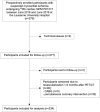Comparison of the prognostic value of impaired stress myocardial blood flow, myocardial flow reserve, and myocardial flow capacity on low-dose Rubidium-82 SiPM PET/CT
- PMID: 36574175
- PMCID: PMC10371877
- DOI: 10.1007/s12350-022-03155-6
Comparison of the prognostic value of impaired stress myocardial blood flow, myocardial flow reserve, and myocardial flow capacity on low-dose Rubidium-82 SiPM PET/CT
Abstract
Background: The most reliable quantitative variable on Rubidium-82 (82Rb) cardiac PET/CT for predicting major adverse cardiovascular events (MACE) has not been characterized with low-dose silicon photomultipliers (SiPM) technology, which allows halving injected activity and radiation dose delivering less than 1.0 mSv in a 70-kg individual.
Methods and results: We prospectively enrolled 234 consecutive participants with suspected myocardial ischemia. Participants underwent 82Rb cardiac SiPM PET/CT (5 MBq/kg) and were followed up for MACE over 652 days (interquartile range 559-751 days). For each participant, global stress myocardial blood flow (stress MBF), global myocardial flow reserve (MFR), and regional severely reduced myocardial flow capacity (MFCsevere) were measured. The Youden index was used to select optimal thresholds. In multivariate analysis after adjustments for clinical risk factors, reduced global stress MBF < 1.94 ml/min/g, reduced global MFR < 1.98, and regional MFCsevere > 3.2% of left ventricle emerged all as independent predictors of MACE (HR 4.5, 3.1, and 3.67, respectively, p < 0.001). However, only reduced global stress MBF remained an independent prognostic factor for MACE after adjusting for clinical risk factors and the combined use of global stress MBF, global MFR, and regional MFCsevere impairments (HR 2.81, p = 0.027).
Conclusion: Using the latest SiPM PET technology with low-dose 82Rb halving the standard activity to deliver < 1 mSv for a 70-kg patient, impaired global stress MBF, global MFR, and regional MFC were powerful predictors of cardiovascular events, outperforming traditional cardiovascular risk factors. However, only reduced global stress MBF independently predicted MACE, being superior to global MFR and regional MFC impairments.
Keywords: Quantitative myocardial perfusion; SiPM PET/CT; low-dose rubidium-82; major adverse cardiovascular events; myocardial flow capacity; outcome.
© 2022. The Author(s).
Conflict of interest statement
Dr. Dietz has nothing to disclose. Dr. Kamani has nothing to disclose. Dr. Allenbach has nothing to disclose. Dr. Rubimbura has nothing to disclose. Dr. Fournier has nothing to disclose. Dr. Dunet has nothing to disclose. Dr. Treglia has nothing to disclose. Dr. Nicod Lalonde has nothing to disclose. Dr. Schaefer has nothing to disclose. Dr. Eeckhout has nothing to disclose. Dr. Muller has nothing to disclose. Dr. Prior has nothing to disclose. The authors declare that there is no conflict of interest.
Figures


Comment in
-
More evidence for prognostic value of quantification of myocardial perfusion.J Nucl Cardiol. 2023 Aug;30(4):1396-1398. doi: 10.1007/s12350-022-03182-3. Epub 2022 Dec 24. J Nucl Cardiol. 2023. PMID: 36565429 No abstract available.
References
-
- Juarez-Orozco LE, Tio RA, Alexanderson E, Dweck M, Vliegenthart R, El Moumni M, et al. Quantitative myocardial perfusion evaluation with positron emission tomography and the risk of cardiovascular events in patients with coronary artery disease: a systematic review of prognostic studies. Eur Heart J Cardiovasc Imaging. 2018;19:1179–1187. doi: 10.1093/ehjci/jex331. - DOI - PMC - PubMed
-
- Zampella E, Acampa W, Assante R, Gaudieri V, Nappi C, Mannarino T, et al. Combined evaluation of regional coronary artery calcium and myocardial perfusion by (82)Rb PET/CT in predicting lesion-related outcome. Eur J Nucl Med Mol Imaging. 2020;47:1698–1704. doi: 10.1007/s00259-019-04534-x. - DOI - PubMed
-
- Harjulahti E, Maaniitty T, Nammas W, Stenstrom I, Biancari F, Bax JJ, et al. Global and segmental absolute stress myocardial blood flow in prediction of cardiac events: [(15)O] water positron emission tomography study. Eur J Nucl Med Mol Imaging. 2021;48:1434–1444. doi: 10.1007/s00259-020-05093-2. - DOI - PMC - PubMed
Publication types
MeSH terms
Substances
LinkOut - more resources
Full Text Sources
Medical

